Duncan Barrett's Blog, page 3
June 15, 2012
Henry Tate’s legacy: The Sugar Girls at South Lambeth Library
On Monday, we will be speaking at South Lambeth Library, along with two of the sugar girls whose stories feature prominently in our book: Gladys Hudgell and Eva Rodwell. It’s a particularly appropriate location since the library is one of four in South London founded on gifts of land or money from Henry Tate, whose company subsequently merged with that of Abram Lyle to form Tate & Lyle.
Mr Tate was a generous philanthropist, and believed strongly that everyone should have access to books, regardless of how rich or poor they were. To this day, the gallery proudly proclaims itself the ‘Tate Free Library’.
Our local library in Brixton is another of Tate’s legacies, and it was there that we first began our research for the book, in early 2011. Here you can see the bust of Mr Tate which stands outside in Windrush Square.
Tate also founded libraries in nearby Balham, and Streatham, where he himself lived. When he died in 1899 he was buried in West Norwood Cemetary. His mausoleum is soon to attract a lot of attention when the Curious Trail exhibition opens on Friday 22nd June. Belfast sculptor Brendan Jamison has recreated the tomb, carved out of Tate & Lyle sugar cubes.
Jamison’s mausoleum sculpture follows a previous commission to sculpt the Tate Modern building in sugar, a task which required 71,908 cubes. But many visitors to the various Tate art galleries around the country don’t realise the connection with the sugar magnate who first donated both his money and his personal art collection to help found the National Gallery of British Art, which subsequently became the Tate Gallery.
Aside from grand gestures of philanthropy, both Henry Tate and Abram Lyle were generous to their employees in the East End factories, and Gladys and Eva have fond memories of Abram’s eccentric grandson Oliver, who ran the old Lyle factory throughout the 1940s and 1950s. The company provided extensive sports facilities, an on-site bar that was open throughout the day, and regular days out on beanos to Margate and Southend.
Come along on Monday to hear Gladys and Eva share their stories of working for Tate & Lyle.
Full details:
6.45pm on Monday 18th June
South Lambeth Library
180 South Lambeth Road
London SW8 1QP
Henry Tate’s legacy: The Sugar Girls at South Lambeth Library
May 16, 2012
Sugar Girls at Goldsmith’s Row book market
The Sugar Girls took part in a brand new East End book market on the weekend. Goldsmith’s Row Book Market, just off Hackney Road and near Columbia Road Flower Market, is a great new addition to the area and features stalls selling everything from second hand novels to limited edition art books, every Sunday from 10am to 4pm.
There were 22 stallholders taking part, including Newham Bookshop, Pages of Hackney, Barrow Books, The Feminist Library, Brick Lane Books, The Art Books Cooperative, Books By Photographers, ArtWords, Foyles (who had a stall dedicated to graphic novels), Donlon, X Marks the Bökship, NB Pictures and 14.19. Next week’s market promises to be even bigger and will include Skoob – one of the biggest secondhand book dealers in London – and photography bookshop Claire de Lune, which will be selling books on fashion.
Former Tate & Lyle workers Gladys Hudgell and Eva Rodwell came along to sign copies of *The Sugar Girls *at the Newham Bookshop’s stall, with* *co-author Nuala Calvi. There were pictures on display of Gladys and her friends from their days at the company’s East End factories in the 1940s and 1950s, when they were “Sugar Girls”. Gladys was particularly pleased when one young man looked at her picture, looked at her, and asked if the photograph “had been taken yesterday”!
After selling a big pile of books, Gladys and Eva headed off to the flower market, which Gladys used to visit every weekend with her late husband, John. She showed she hadn’t lost her touch when she shouted down a market seller who was selling orchids, telling him to “shut up and be quiet for a minute”, before managing to get an orchid off him for just a fiver.
If you’d like to meet Gladys and Eva – two of the women whose stories feature in *The Sugar Girls: Tales of Hardship, Love and Happiness in Tate & Lyle’s East End* – come to our next book signings at Waterstones in Bluewater on June 16 and Waterstones in Ilford on June 23, from 12pm.
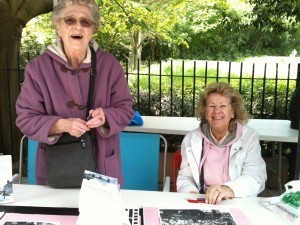
May 1, 2012
Sheila Oakley – a sugar girl in Canada
One of our most pleasurable experiences since The Sugar Girls hit the shelves over a month ago has been reading the many letters and emails we have received from readers who also worked at Tate & Lyle, and who have their own memories to share. Sometimes we feel like kicking ourselves that we didn’t encounter them sooner, so that we could have included their stories in the book.
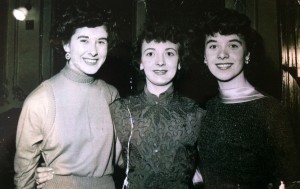
Sheila Oakley (right) and fellow syrup fillers Jean Tampkin and Sylvie Bullock at the Lyceum Ballroom, October 31st 1955
Sheila Pavelin (nee Oakley) made even more effort than most to get in touch with us, sending us an eight-page handwritten letter all the way from Ontario, Canada, where she now lives. Sheila joined the Plaistow Wharf refinery as a syrup filler in 1952 at the age of 15, and was later transferred to the Blue Room.
Sheila recalled the wonderful beanos the department would take to Southend, the paper hats that read ‘Kiss Me Quick’ on them – and one day out in particular when a boatload of sailors had just docked and were looking forward to some shore leave. Sheila and her friends were rather surprised when the ‘old gels’ of the department (who at thirty-plus were regarded by the younger girls as spinsters) managed to nab all the sailors for themselves, before the younger women got a look in. None the less, the whole group had a ‘good old knees-up’ together, and the sugar girls organised a whip round to pay for a feast of fish, chips, jellied eels, cockles, shrimps and whelks for the sailors.
But perhaps most fascinating for us, Sheila’s letter provided an insight into the labour manageress at the factory, Miss Florence Smith. Nearly every woman we interviewed mentioned Miss Smith, generally as a terrifying boulder of a woman, who struck fear into the heart of the girls – she was known around the factory as ‘The Dragon’. But as we interviewed more and more women, we heard about another side of Miss Smith too, beneath the formidable exterior: she would look out for any orphans who worked at the factory, and worked hard to protect her girls’ best interests – as she did with Sheila.
Sheila told us that her father was a terribly mean man, who began docking his wife’s housekeeping money as soon as their daughters started work, demanding that they make up the shortfall. Sheila actually transferred to Tate & Lyle from another job as a way around this policy – she didn’t tell her dad that she was being paid more, so she and her mum were both better off.
Sheila’s parents would often row, and one day her mother took off to stay with her sister in Finchley, declaring that she wasn’t coming back. Sheila’s dad demanded that she quit her job at the factory and take over raising her two younger siblings: a boy of 12 and a little girl of 3. When Sheila phoned to pass on the news to Tate & Lyle, Miss Smith asked her to come into her office, and soon learned the full situation. The next day she was round at the Oakley household herself, berating Sheila’s dad for the way he was treating her, and demanding that he pay her a decent wage for her work.
Predictably, Mr Oakley was furious and demanded that Miss Smith leave immediately, but ‘The Dragon’ was not easily intimidated. She informed him that he was breaking the law using his daughter as a domestic servant, and that as one of her charges Sheila’s welfare was her business – and she told him in no uncertain terms that bringing up the children was his and his wife’s job, not Sheila’s.
In the end, Sheila was able to persuade her mother to come home, but her father never forgave her for – as he put it – ‘going to the authorities’.
If you worked at Tate & Lyle and have stories and pictures to share, we would love to hear from you. You can get in touch by email on sugargirlsbook@hotmail.co.uk.
April 23, 2012
The Sugar Girls at the Redbridge Book Festival
Last Friday, we were delighted to be speaking at Wanstead Library, as part of the fabulous Redbridge Book Festival. Joining us on the stage were Gladys and Eva, two of the sugar girls featured in the book, who shared their stories with an audience of more than 120 people.
Gladys recalled how she had originally hoped to become a nurse, only taking a job at Tate & Lyle after her dad informed her that nursing involved ‘holding old men’s willies while they pee’. Eva, meanwhile, spoke of the perils of sharing a workplace with your father – on one occasion he caught her in the onsite bar with a co-worker who was so drunk that when they returned to work in the bag-printing she ended up covered in blue ink.
It was wonderful to see such a huge turnout for the event, and amongst the audience were a married couple who had met at Tate & Lyle’s Thames Refinery in the 1970s: Stanley and Janet Copp. We had spoken to the Copps on the phone when researching The Sugar Girls, but it was great to finally meet them face to face.
Stanley started work at Tate & Lyle as an apprentice in 1945 at the age of 16, and remained there for many decades. Janet joined in 1970, and after a brief stint as a sugar-packer (which she found exhausting) was lucky to score a transfer to the staff restaurant. She herself spent 18 years at Tate & Lyle, before taking redundancy in the late 1980s.
If you missed the event last Friday and would like to have your book signed by Gladys and Eva, they will be with us at the inaugural Goldsmith’s Row Market, a new book market, on 13th May. We’ll be on the stall of the wonderful Newham Bookshop, who organised the event at Wanstead as well. For more details on Goldsmith’s Row, click here.
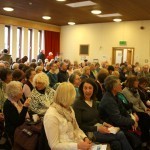
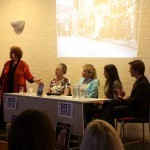

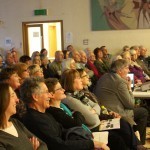
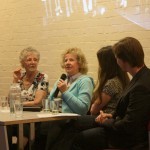






April 18, 2012
Lilian’s suitcase of memories
At the weekend we paid a visit to Lilian, one of the four main women featured in The Sugar Girls, to take a look at her photo collection. Previously, Lilian had told us that she didn’t have many pictures of her childhood or her time at Tate & Lyle, as she didn’t consider herself a ‘hoarder’.
When we got to her house, however, she retrieved a battered old suitcase from an upstairs room. It was locked and she no longer had the key to it, so she suggested that we try to prise the lock open. We wrestled with it using our house keys (snapping one of them in the process) and finally got the case unlocked – and discovered a treasure trove of pictures inside that Lilian hadn’t looked at for years.

Lilian showing us her pictures
All the people, places and experiences that she had told us about for the book came to life before our eyes. Here is Lilian (far left) as a child in the back yard at 19 Conway Street, with her siblings Harry, Sylvie (on the swing) and Edie. You can see how poor the family were from the holes in Lilian’s shoes.

Lilian as a child with siblings Harry, Sylvie & Edie.
Lilian’s mother was thrilled when her family were rehoused in new flats near West Ham Station and finally had an indoor bathroom and separate bedrooms.
During the Second World War, the family were evacuated to the countryside, where Lilian’s sister Edie met a young soldier who got her pregnant. Edie eventually married him and moved to the countryside in Suffolk, where her East End family would come and visit her. Here are Mr & Mrs Tull paying a visit.

Lilian's parents, Harry and Edith Tull
And here is Lilian (far right) and her two sisters, looking a bit more grown up.
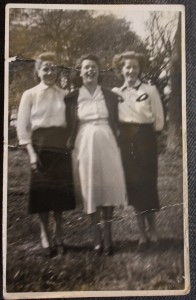
Lilian and her sisters
Lilian started work at Tate & Lyle just after the war, at the age of 23, and the new job brought with it a whole new world of friendship and fun which is so perfectly captured in the many photos she has of beanos and days out with her friends. Here she is on the Royal Daffodil, heading off to Margate with her fellow can-making girls. Lilian is third from the left, her friend Little Lil is second from the left, and their mate Old Fat Nell can be seen on the far right.
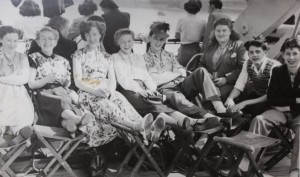
Lilian and friends on the Royal Daffodil
Tate & Lyle were good to Lilian, sending her to a convalescent home in Weston-super-Mare when she came out in boils from the stress of caring for her sick mother. She had a great time and made new friends there.
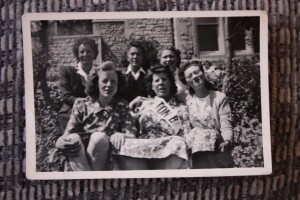
Lilian (front row, left) in Weston Super-Mare
It was on a Tate & Lyle beano that Lilian met her future husband, Alec – who became her rock throughout all the tragedies she faced over the course of her life. Here they are on their wedding day, looking blissfully happy together.
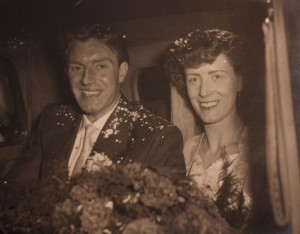
Lilian and Alec on their wedding day
These days, Lilian is widowed, but her constant companion is her friend Flo – also a former sugar girl – and the two of them are now inseparable.
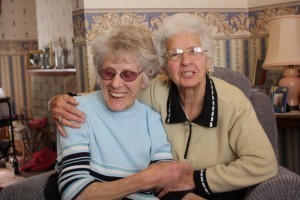
Lilian and Flo
We are always keen to add new stories and pictures to our blog, so if you worked at Tate & Lyle and have pictures that you can send us, click here to get in touch.
April 14, 2012
The Sugar Girls book signing at Tate & Lyle
Earlier this week, we attended a very special book-signing in the canteen of Tate & Lyle’s Thames Refinery in Silvertown. Community Affairs Manager Ken Wilson had organised a display board of pictures of the sugar girls, and had invited Colin Lyle – son and nephew, respectively, of former factory directors Philip and Oliver Lyle – to come along. Sugar girls Gladys and Eva were there too – and they told us that the food in the modern Tate & Lyle canteen compared very favourably to what they remembered from the 1940s and 1950s!
It was fantastic to meet current Tate & Lyle employees who had already begun reading the book, and who told us how much they enjoyed learning more about the company’s past. Ken was particularly pleased that several contractors, who had only been working for the firm for a few months, seemed as keen to learn about the history of Tate & Lyle and the sugar girls as those who had been working there for decades.
Many of the current Tate & Lyle workforce told us what a pleasure it was to meet Colin Lyle, a member of one of the original founding families. One man spoke to him about how four generations of his family had worked for the company, his great-grandfather having travelled down to London with Abram Lyle himself in the 1880s. Meanwhile, current ‘sugar girls’ at the factory were very keen to speak to Gladys and Eva about what it was like at Tate & Lyle half a century ago.
By the end of the lunch hour, we had signed so many copies that Gladys was complaining of cramp in her hand – and Vivian Archer from the Newham Bookshop, who was selling the books, nearly ran out of stock entirely.
If you would like to meet some of the sugar girls in person – and have your book signed by them – come along to Wanstead Library next Friday (20 April), where there will be a book talk featuring Duncan, Nuala, Gladys and Eva, as part of the Redbridge Book Festival. There’s more information here - tickets cost £5 and early booking is advised.



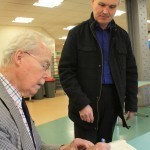
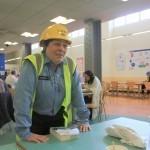

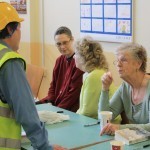
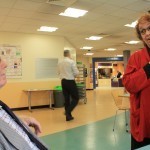
April 11, 2012
Four generations of one family at Tate & Lyle!
We always knew that Tate & Lyle was a family firm, in more ways than one. Not only did the Tate and Lyle families used to run their two old East End factories, but many generations of workers within a single family would often work there side by side.
Even so, the story we heard recently from Joan Lewis is quite remarkable. Her great grandfather Hugh McMarth was one of the original workers who came down from Scotland with Abram Lyle in the 1880s to start up the Plaistow Wharf Refinery. The family had a house built for them in Boxley Street, Silvertown, and settled there. When their children left school, they went to work at Tate & Lyle as well, although one was killed in the Silvertown Explosion of 19 January 1917.
Joan's grandfather, Hugh Jnr, became a manager at Tate & Lyle, and his own children followed him into the factory too – Joan's father William was an apprentice tin-printer and eventually a lorry driver, while her aunt Mary worked on the Hesser Floor in the 1940s and 1950s with some of our sugar girls, and remained in Silvertown until the 1990s.
Even today, Joan has a cousin working for Tate & Lyle, and she has fond childhood memories of the children's parties and trips to Olympia to see the ice skating that the company would lay on. She still visits Boxley Street from time to time, but told us that 'Silvertown has changed so much from the days when most of my neighbours made their way to work in Tate & Lyle.'
Joan sent us the following wonderful photographs of her family in Silvertown.

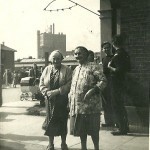
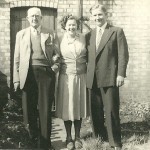
April 9, 2012
The Sugar Girls is a Sunday Times bestseller!
We're very pleased to announce that The Sugar Girls  has entered the Sunday Times bestseller list this weekend.
has entered the Sunday Times bestseller list this weekend.
We never thought we would be on the same list as Jennifer Worth's Call The Midwife , which was a big inspiration to us while writing our book and one of the first things that got us interested in researching East End history.
, which was a big inspiration to us while writing our book and one of the first things that got us interested in researching East End history.
Jennifer Worth's influence on the chart is clear, with another midwife book, Maria Anderson's Tales of a Midwife , making it in at number nine.
, making it in at number nine.
Babies are a hot topic, with Cathy Glass's A Baby's Cry – about her experiences as a foster carer – at number two and Angela Patrick's The Baby Laundry for Unmarried Mothers
– about her experiences as a foster carer – at number two and Angela Patrick's The Baby Laundry for Unmarried Mothers at number seven.
at number seven.
The Sugar Girls includes two stories of young women who were sent away to have their babies at unmarried mothers' homes in the 1940s and 1950s – Edie Tull (Lilian's sister) and Joan Cook.
Edie became pregnant by a soldier during the Second World War, and by the time she found out he had already gone abroad to fight. When she finally got word to him that she was having his baby, he had some unexpected news for her too: he was already married.
Joan's boyfriend Alfie was on leave from his national service when they slept together for the first time, and she got pregnant. Her mother made her quit her job at Tate & Lyle without explaining to any of her friends why she was leaving, and sent her to an unmarried mothers' home in Highbury, North London, run by nuns. Her baby, Terry, was born in 1958 and adopted – and to this day Joan hopes that he will track her down and make contact.

April 7, 2012
The Sugar Girls make the Robert Elms podcast
If you missed the Sugar Girls on the Robert Elms show on BBC London last week, you can now listen to the interview on the programme's podcast, here:
On air with Robert were Duncan Barrett and former Sugar Girls Gladys Hudgell and Eva Rodwell, who made quite an entrance – their taxi was caught in traffic and it was touch and go whether they would make it in time for the show. Then when they did turn up, they breezed into the studio unaware that they were going straight on air – a bit of a shock for all concerned!
Robert clearly found it hilarious, however, and launched into his first questions for Gladys and Eva while they were still bustling about making themselves comfortable. When he told Gladys her bag was making a rustling noise she told him that, at 79, she was entitled to rustle if she wanted to!
The interview was interrupted twice by Gladys's mobile phone going off, as her son Paul kept ringing to check whether she was on the radio. The production crew were in stitches and Robert said afterwards that it was "one of the finest and funniest interviews I've done for many a moon".
There's also a bonus audioboo interview with Gladys and Eva conducted by Robert's producer Graham, which you can listen to here (and no phone calls were taken in that one!).
listen to 'Original 'Sugar Girls'Gladys & Eva chat to Graham about life in a 1950′s London Sugar Refinery.' on Audioboo
Find out more about Gladys, Eva and the other women who made Tate & Lyle one of Britain's most famous brands in The Sugar Girls, published by Collins. Click here to buy the book for just £3.77 with free delivery.
The Second World War at Tate & Lyle
Today, we received this fascinating email about Tate & Lyle during the war years from a woman called Val Connelly, whose grandmother used to run a ship's laundry in Constance Street, Silvertown:
"During the war, people were told to shelter in Tate & Lyle's factory – sitting on the bags of sugar! They were lifted up into the loading bay by the men when the siren had gone but what would have happened if a bomb had dropped on all that sugar – with the girls sitting on it – doesn't bear thinking about. One of my aunts had been in the bath one day when the siren went and she just put a coat on and ran. When she got the loading bay, she realised that everyone would see she had nothing on so she clamped her legs together and the men had to lift her stiff body up. They complained and told her to use her legs but she couldn't – she was too embarrassed!"
Val then adds, "Incidentally, my grandmother apparently had a bottle of poison ready to give to her daughters if the Germans had invaded. As she said, 'No German is getting my girls.' A neighbour's daughter who heard about this actually asked my grandmother to include her in the poisoning!"
When we were writing our book The Sugar Girls, we came across many wonderful stories about Tate & Lyle's factories in the Second World War, and unfortunately we just didn't have room to include all of them. A former sugar girl called Clare Sullivan told us about a group of Italian POWs from a camp in nearby Canning Town who were brought into the Thames Refinery to help with some heavy lifting in the sack department. The women there were unimpressed with the fascist foreigners, spitting in their faces and declaring they would rather do the work themselves.
Another story we came across was that of Doris Martineau, a sugar girl at Thames who was determined to raise enough money to pay for an RAF bomber. Through fun fairs and raffles, Doris managed to collect £20,000 from her fellow workers – enough to purchase the plane, which was christened 'The Golden Lion' after the old Lyle company mascot.
We also heard the story of Win Hardy, a former sugar girl now living in Australia who worked on the Hesser Floor at Tate & Lyle's Plaistow Wharf Refinery from 1935 to 1941. Win's is now 95, and her story was told to us by her son Mike:
"During the winter of 1940/1941, she was living with her sister and brother-in-law in St Albans Avenue. As usual there had been bombing that night and Win was up early to go to work. She was out the door by 7 a.m. It was still very dark and very quiet, not a sound anywhere. She walked down the middle of the road (didn't use the footpaths in case any tiles had been shaken loose and came down as you walked past) and turned into Charlemont Road and then heard a voice calling for help. Win walked toward the voice.
"Charlemont Road had Plane trees down each side of the road at the time – I think it still does – and as Win got closer to the source of the voice, she could see something white at the top of one of these trees. She realised it was a parachute and at the other end just a few feet above the ground was a bomb swinging backwards and forwards towards a lady standing in her front door way. Win told her be quiet in case her shouting set it off! Win then ran to a wardens hut and told the wardens about the bomb. The warden told Win to go along the back gardens in Charlemont Road and get everybody up and out. Win vaulted every fence and hedge, which she didn't know she could do. The warden asked her to help with the other side of the road, but she said she was late for work and she might get the sack. She said to the warden that she wanted a piece of the parachute.
"When she got to work, late, all the workers were outside, because exactly the same thing had happened there – a bomb, suspended on a parachute was hanging from an upper balcony of the factory. Win got told off and was docked some money for being late. When she got home from work that night, there was a package waiting for her – it was some parachute silk. Apparently the incident was mentioned in the local paper about a heroine that had saved the street, but win wasn't mentioned by name."
If you want to read more about Tate & Lyle during the war years, check out this previous blog, which features a letter written by factory director Philip Lyle to a friend in America describing the effect of the Blitz on the factories.
Click here to order The Sugar Girls on Amazon for just £3.77 inc. delivery.






